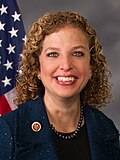Current delegation
| Current U.S. senators from Florida | ||||
|---|---|---|---|---|
Florida
| Class I senator | Class III senator | ||
 Rick Scott (Senior senator) (Naples) |  Ashley Moody (Junior senator) (Tampa) | |||
| Party | Republican | Republican | ||
| Incumbent since | January 8, 2019 | January 21, 2025 | ||
Florida's current congressional delegation in the 119th Congress consists of its two senators, both of whom are Republicans, and its 28 representatives: 20 Republicans and 8 Democrats. Per the 2020 United States census, Florida gained one new congressional seat starting in the 2022 midterms. [2]
The current dean of the Florida delegation is Representative Mario Díaz-Balart of the 26th district , having served in the House since 2003.
| Current U.S. representatives from Florida | |||||
|---|---|---|---|---|---|
| District | Member (Residence) [3] | Party | Incumbent since | CPVI (2025) [4] | District map |
| 1st |  Jimmy Patronis (Fort Walton Beach) | Republican | April 2, 2025 | R+18 |  |
| 2nd |  Neal Dunn (Panama City) | Republican | January 3, 2017 | R+8 |  |
| 3rd |  Kat Cammack (Gainesville) | Republican | January 3, 2021 | R+10 |  |
| 4th |  Aaron Bean (Fernandina Beach) | Republican | January 3, 2023 | R+5 |  |
| 5th |  John Rutherford (Jacksonville) | Republican | January 3, 2017 | R+10 |  |
| 6th |  Randy Fine (Melbourne Beach) | Republican | April 2, 2025 | R+14 |  |
| 7th |  Cory Mills (New Smyrna Beach) | Republican | January 3, 2023 | R+5 |  |
| 8th |  Mike Haridopolos (Indian Harbour Beach) | Republican | January 3, 2025 | R+11 |  |
| 9th |  Darren Soto (Kissimmee) | Democratic | January 3, 2017 | D+4 |  |
| 10th |  Maxwell Frost (Orlando) | Democratic | January 3, 2023 | D+13 |  |
| 11th |  Daniel Webster (Clermont) | Republican | January 3, 2011 | R+8 |  |
| 12th |  Gus Bilirakis (Palm Harbor) | Republican | January 3, 2007 | R+17 |  |
| 13th |  Anna Paulina Luna (St. Petersburg) | Republican | January 3, 2023 | R+5 |  |
| 14th |  Kathy Castor (Tampa) | Democratic | January 3, 2007 | D+5 |  |
| 15th |  Laurel Lee (Tampa) | Republican | January 3, 2023 | R+5 |  |
| 16th |  Vern Buchanan (Sarasota) | Republican | January 3, 2007 | R+7 |  |
| 17th |  Greg Steube (Sarasota) | Republican | January 3, 2019 | R+11 |  |
| 18th |  Scott Franklin (Lakeland) | Republican | January 3, 2021 | R+14 |  |
| 19th |  Byron Donalds (Naples) | Republican | January 3, 2021 | R+14 |  |
| 20th |  Sheila Cherfilus-McCormick (Miramar) | Democratic | January 18, 2022 | D+22 |  |
| 21st |  Brian Mast (Fort Pierce) | Republican | January 3, 2017 | R+7 |  |
| 22nd |  Lois Frankel (West Palm Beach) | Democratic | January 3, 2013 | D+4 |  |
| 23rd |  Jared Moskowitz (Parkland) | Democratic | January 3, 2023 | D+2 |  |
| 24th |  Frederica Wilson (Miami Gardens) | Democratic | January 3, 2011 | D+18 |  |
| 25th |  Debbie Wasserman Schultz (Weston) | Democratic | January 3, 2005 | D+5 |  |
| 26th |  Mario Díaz-Balart (Miami) | Republican | January 3, 2003 | R+16 |  |
| 27th |  María Elvira Salazar (Miami) | Republican | January 3, 2021 | R+6 |  |
| 28th |  Carlos A. Giménez (Miami) | Republican | January 3, 2021 | R+10 |  |